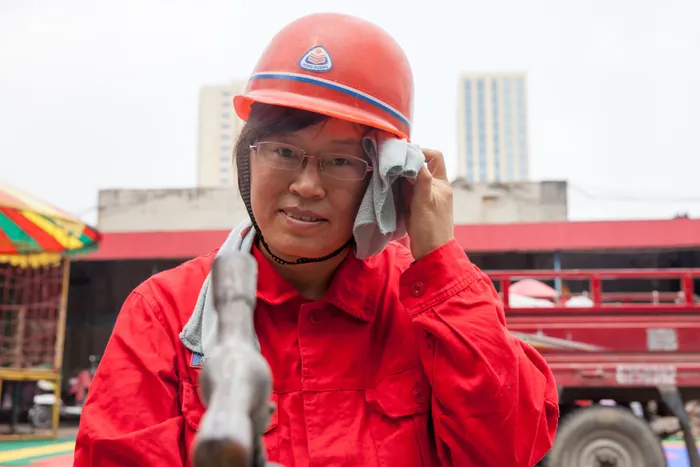Mitigating the impact on workers’ rights a key priority

Picture: (Xinhua/Zhang Weitang) (wyo)
By Ratidzo Makombe
SOUTH Africa’s increased load shedding for much of last year and into this year sparked a debate on the use of alternative forms of energy to relieve pressure on the country’s grid.
One of the critical debates within the government has been the much-anticipated just transition “to reduce the negative impacts on workers and communities of transitioning to a zero-carbon economy while ensuring that benefits are fairly distributed”.
The Just Transition framework in South Africa was mooted by the Presidential Climate Commission. It addresses practical issues relating to jobs, local economies, skills, social support, and governance.
Like many countries, South Africa continues to grapple with the impacts of climate change. These have apparently manifested through extreme weather events such as the Durban floods, which had ramifications for livelihoods in KwaZulu-Natal.
The country also frequently goes through periods of drought, and these events are said to likely increase due to the advent of climate change.
South Africa already grapples with several issues, such as poverty, unemployment, and inequality. Climate change has compounded these.
Within discussions concerning a just transition, there has been a debate surrounding an energy transition. This links strongly to the country’s current predicament due to incessant power cuts.
A just transition to renewable energy would see the country shift to using alternative forms of energy such as hydropower, wind, solar, geothermal energy, and biomass.
An energy transition would not only arrest a degenerating climate change but will also provide alternative forms of energy for a country in desperate need of this.
A just transition is vital within the global dynamics of South Africa’s carbon emissions.
In 2019, the Global Carbon Atlas ranked South Africa as the 12th highest emitter in the world, with the country being the highest emitter in Africa.
In 2018, the Union of Concerned Scientists estimated that South Africa was the 13th largest emitter of carbon dioxide and, again, the largest emitter in Africa.
The World Bank, in 2016, listed South Africa as the 13th highest emitter in the world, with 477 million metric tons of emissions.
When analysing South Africa’s consumption, it has been noted that electricity production is one of the most significant contributing factors to carbon dioxide emissions.
The concept of a just energy transition emerged in the 1970s during the labour movements from countries like the US and Canada, who, at the time, were at loggerheads with chemical companies that were degrading the environment. The labour movement was demanding that workers and communities should not be affected when changes are made towards shifting towards protecting the environment.
Several countries have adopted Just Transition strategies.
In 2010, the EU called on member states to abandon financial support to non-performing coal mines and shut them down by December 31, 2018.
Due to this, Spain’s power generation fell from 40% in 1990 to 5% in 2019. Employment was severely affected, with only 1700 employed within the sector in 2017, a massive fall in 1990 when 45 000 were employed within the industry.
In Spain, agreements had a five- step process which included identifying territorial boundaries covered by the agreement, assessing the jobs that would be lost, challenges and opportu nities in the region, and negotiations to be entered.
This transition in Spain would ensure that the workers were protected and still be protected. The Just Transition in Spain is a model which could benefit South Africa in its endeavours.
For South Africa, the Just Transition network is positioned at the heart of climate change and speaks to the country’s broader debates on economic development.
The framework aims to manage the social and economic consequences of policies that shift the country to renewable energy.
The framework for South Africa’s Just Transition framework is as follows:
- Foundations on which the framework builds
- Definition of a just transition for South Africa
- Principles to guide the transition
- At-risk sectors and value chains
- Key policy areas to give effect to the transition
- Effective governance arrangement
- Financing a just transition.
The fear of a just transition in South Africa concerns the plight of workers in the country. Cosatu, in 2009, highlighted that a just transition must “protect the most vulnerable from the effects of climate change.”
The protection of workers, as with the Spanish case, shows the impacts of climate change and the need for governments to implement measures to mitigate the challenge.
The Bill of Rights in South Africa enshrines first, second, and third- generational rights. Third collective generation rights focus on the environment and sustainable development.
The Just Transition framework in South Africa advances principles that are primarily linked to environmental justice and focus on resilience which can be increased by protecting the country’s strategic water source areas, improving ecosystem services and biodiversity, and implementing sustainable land-use practices.
A just transition offers the country a chance to protect the environment and ensure the safety of workers.
As the world continues to bear the brunt of climate change, governments must take measures to address its impacts.
- Makombe is a doctoral candidate in development studies and a researcher at the University of Johannesburg’s Institute for Pan-African Thought and Conversation.